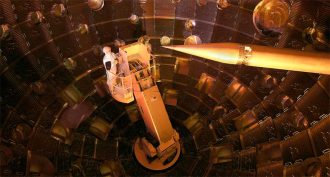HS-PS1-8
Develop models to illustrate the changes in the composition of the nucleus of the atom and the energy released during the processes of fission, fusion, and radioactive decay.
-
 Earth
EarthWhen life exploded
Life exploded in diversity during the Cambrian Period. Experts are exploring what could account for this sudden change 540 million years ago.
By Beth Geiger -
 Chemistry
ChemistryScientists confirm element 117
Scientists have confirmed the existence of a new, short-lived superheavy element. For now, they’re calling it ununseptium.
By Janet Raloff -
 Animals
AnimalsWe are stardust
Everything making up Earth and what’s now living upon it — from trees and people to our pets and their fleas — owes their origins to the elements forged by ancient stars.
By Beth Geiger -
 Physics
PhysicsClosing in on fusion energy
Scientists blasted a tiny capsule of hydrogen with laser beams, setting off a reaction that released more energy than in earlier experiments. Still, scientists remain a long way from creating a reaction that releases more energy than it needs to get started.
-

Kids’ ingenuity honored at Intel ISEF
Young scientists receive awards in international competition.
-

-
 Earth
EarthQuake leaves destruction, fear
In Japan, an earthquake started a tsunami that caused a nuclear disaster.
-
 Space
SpaceBurst busters
A powerful type of explosion in outer space is much more common, but not always as powerful, as astronomers had thought.
By Emily Sohn